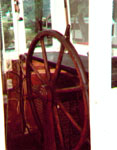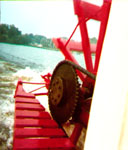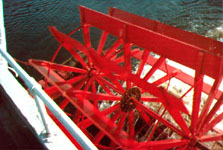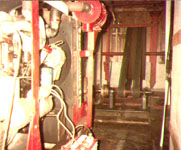
BOAT |
OVERALL |
MAXIMUM |
GROSS |
MAXIMUM |
POWER |
OWNERS |
CITY OF WEBSTER |
40' |
9' |
8 tons? |
18" ? |
steam |
Joe Breeck (1906-1913) |
ETHEL H |
45' |
12' |
10 tons? |
22" ? |
steam |
John Mock (1906-1908) |
DIXIE (1914-1928) |
65' |
14' |
18 tons? |
14" |
steam |
Joe Breeck (1914-1928) |
DIXIE (1929-Present) |
76'-3" |
17'6" |
35 tons |
22" |
steam |
Joe Breeck (1929-1939) |
• The first Dixie's original powerplant was a one-lung, reciprocating steam engine which developed 8 horsepower. According to Jim Hamman, this steam engine was used briefly on the present Dixie when it was first launched in 1929. By the 1920's, the first Dixie would be powered by a 15hp single-cylinder gasoline engine, and later, a Fordson tractor.
• The large area of lake shore property which became Epworth Forest was sold from atop the first Dixie in 1924.
• Ohio Riverboat Captain Leon Ash piloted the Dixie for much of the 1927 season.
• The first 8 feet of the Dixie's hull is double steel plated along its bottom. This provides extra strength when beaching or hitting snags.
• The Dixie still has its original ship's wheel, known on sternwheelers as the "pilotwheel". The Dixie's pilotwheel is nearly 100 years old and is from an authentic Ohio River boat. Joe Breeck brought the wheel with him from Madison Indiana around 1914, for use on the first Dixie. The winter of 1913 had been a devastating year on the Ohio River. Ice flows had destroyed many vessels, including the ferry "LEON", which Breeck operated between Carrollton, Kentucky and Lamb, Indiana. There is some speculation as to whether Breeck got the Dixie's pilotwheel from a wrecked steamboat in the Cincinnati area, the shipyard at Madison, Indiana, or from the wrecked ferry "LEON" at Lamb, Indiana.

• The Dixie has 6 speeds forward and 6 in reverse. The slowest gear turns the paddlewheel at 16 rpm. Second gear is the normal cruising speed of 8 mph, with the paddlewheel turning at 22 rpm. Third gear turns the paddlewheel at 24 rpm. Sixth gear is the fastest speed (about 10 mph) with the paddlewheel turning at 28 rpm.


• From 1950 to 1980, the Dixie's official seating capacity was 202. The record number of passengers in one trip was 285 (set by Jay Knapp in the 1930's).
• The Dixie's hull is completely flat-bottomed. This gives the boat an extremely shallow draft of about 14 inches (empty). The hull is strengthend by a series of 42 angle-iron ribs, and 2 keel angle-irons, which extend from bow to stern. Most of the ribs are equipped with a hog chain.

• The Dixie's diesel-electric powertrain was installed by Earl Ungeright in 1949. The original generator was a 1944 Waukesha Army field unit. This lasted until 1977, when Tag Huffman replaced the diesel engine and had the generator armature rebuilt.
